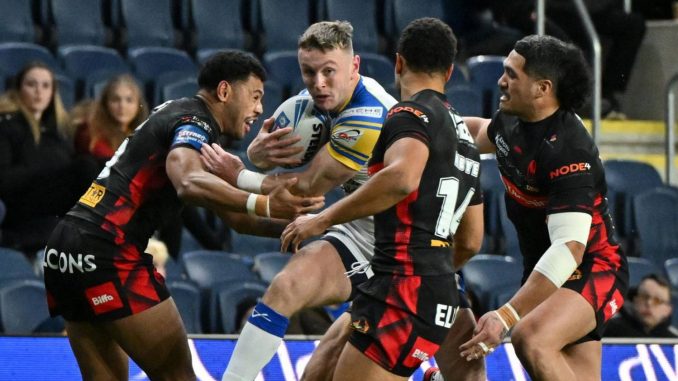
Leeds Rhinos’ attack problem laid bare as issue with new spine becomes apparent

The Rhinos have had a steady start to the season but there is an issue that needs to be addressed.
After a doubleheader against St Helens, Leeds Rhinos’ performances and prospects have been scrutinised. Their attack has been a talking point after struggling to post enough points.
Rohan Smith’s side were only able to score two tries in two games against St Helens, with one of those being a length-of-the-field intercept by centre Harry Newman. Saints have been an outstanding defensive unit for some time, but with Leeds supporters vying for a return to major finals, it’s a concerning fact for all involved.
Statistically, it has to be said that it doesn’t make for great reading either. Five games into the season, only three teams have scored fewer points than the Rhinos: Hull FC, Castleford Tigers and London Broncos. Some context is required, as the same three teams have conceded the most points too. After five rounds, Leeds are the only team not to play one of those sides.
But even that can’t hide from the fact that with the ball, there are elements of the Rhinos’ attack that haven’t been good enough, and there’s one metric in particular that highlights their biggest problem: attacking with good ball.
A key statistic many coaches look at is the number of play the balls it takes for their team to score when attacking in an opponent’s 20-metre area. It’s a statistic that generally shows how good teams are at turning good territory into points. Statistically, Leeds Rhinos are currently the worst team in the league in that department.
In their five Super League games so far, Leeds have played the ball in an opponent’s 20-metre area 105 times. However, they have only scored six times, which comes out to an average of 17.5 play the balls per try.
For context, Wigan Warriors are the leaders with an average of 6.1, a huge improvement on how Leeds are currently tracking. But they are being outperformed considerably by most other teams in this department, with seven teams averaging better than a try per two sets in an opponent’s 20.
Play-the-balls per try in opponent’s 20
Wigan Warriors 6.1
Warrington Wolves 7.1
Leigh Leopards 8.4
St Helens 9.5
Huddersfield Giants 10.5
Hull KR 10.7
Catalans Dragons 11.3
Salford Red Devils 11.7
London Broncos 12.4
Castleford Tigers 15.1
Hull FC 17.0
Leeds Rhinos 17.5
On the flip side, Leeds are more dangerous than almost every team from long distance, but most points are scored from close-range and Leeds’ inability to perform in that department has been an issue.
The Rhinos have scored some spectacular tries this season. The coast-to-coast effort from Ash Handley against Salford, the winger’s try from Brodie Croft’s sublime cross-field kick against Hull KR. He finished off an excellent try against Leigh too. It’s a brilliant ability to have but ultimately, relying on those tries to win games isn’t often enough, certainly not against the top teams.
So why are Leeds struggling in this department? There are some mitigating factors. As mentioned earlier, they haven’t yet played the three worst defensive teams in the competition and there has to be an acceptance that with a brand new spine, their attack won’t kick into gear straight away, it needs some time.

But one dynamic that has perhaps caused teething problems is the playing style of fullback Lachie Miller. The Australian has showcased his skillset; his evasiveness has seen him move to second on Super League’s individual tackle bust charts. Miller is clearly a run threat, but it remains to be seen how Leeds intend to implement that nearer the try line when there is less space to exploit.
Leave a Reply